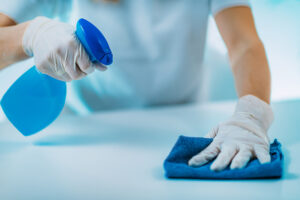Common Questions About Disinfecting Surfaces
What is cleaning and why is it important?
Cleaning is the first step of any disinfection process. Cleaning a surface removes any organic matter and visible solids, both of which interfere with microbial inactivation. The physical act of scrubbing while using detergents and surfactants and then rinsing with water, removes a substantial amount of microorganisms. If a surface is not cleaned prior to disinfection, it compromises the disinfection process. Removal of all visible blood and inorganic matter can be as critical as their germicidal activity of the disinfecting agent. If a surface cannot be cleaned properly, like upholstery, it should be protected with barriers.
What is the difference between disinfection and sterilization?
Disinfection destroys MOST pathogenic and other microorganisms through physical and/or chemical means. In contrast, sterilization destroys ALL microorganisms. Disinfection does not ensure the degree of safety associated with the sterilization process.
What are the different types of disinfectants?
There are three levels of disinfection: high, intermediate, and low. High-level disinfectants are used as a chemical sterilant and due to their harsh nature, should never be used on environmental surfaces. EPA registered Intermediate-level disinfectants have a tuberculocidal claim and are used in dentistry anytime there is visible blood; and in medical facilities whenever there is greater than 10cc of blood or bodily fluid. EPA registered low-level disinfectants have a hep B claim, which is the minimum for patient care areas. Frequently touched surfaces, like doorhandles should be cleaned using an EPA-registered disinfectant that has a claim to kill Covid/SARS CoV2 virus.
If tuberculosis is not transmitted by contaminated environmental surfaces, why is a disinfectant with tuberculocidal claim important?
The ability for a chemical to kill Mycobacterium tuberculosis is used as a benchmark to how well a disinfectant can kill germs because Mycobacteria have among the highest levels of resistance of all microorganisms.
Are disinfecting wipes, clothes, or towelettes the same as traditional spray disinfectants?
When used correctly, disinfectant wipes are effective for cleaning and disinfecting environmental surfaces. Any disinfectant used should be registered by the EPA and be approved for use in healthcare settings. Always follow manufacturer recommendations while using disinfectants. Amount, dilution, contact time, safe use, and disposal are all important. Disinfecting wipes that can be purchased in a general retailer typically have a lowered ability to disinfect.
What is the “spray-wipe-spray” or “wipe-discard-wipe” technique?
Both techniques refer to a two-step procedure that is used to clean and then disinfect surfaces. If using liquid disinfectant, the user would spray the surface with the disinfectant and wipe it using a disposable towel to clean the surface (“spray-wipe”), followed by another “spray” to disinfect the surface. When using disposable disinfectant wipes, the process is described as “wipe-discard-wipe” because the user uses one wipe to clean the surface, discards the wipe, and uses a second wipe to disinfect the surface.
Should Personal Protective Equipment (PPE) be used while cleaning and disinfecting?
Because of risks associated with using harsh chemical disinfectants, healthcare personnel should wear appropriate PPE to prevent exposure to infectious agents or chemicals. PPE can include gloves, gowns, masks, and eye protection. It is important to follow manufacturer instructions and review the manufacturer Safety Data Sheet regarding correct procedures for handling hazardous chemicals.
Can my office have carpeting and cloth furnishing in patient care areas?
Carpeting and cloth furnishings are harder if not impossible to keep clean, compared to nonporous, hard-surface flooring. It cannot be reliably disinfected, especially after spills of blood and bodily substances. Carpet flooring and upholstered furnishings are NOT recommended for use in operatories, laboratories, or instrument processing areas.

